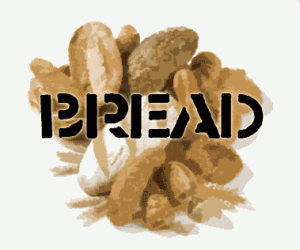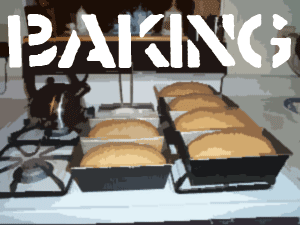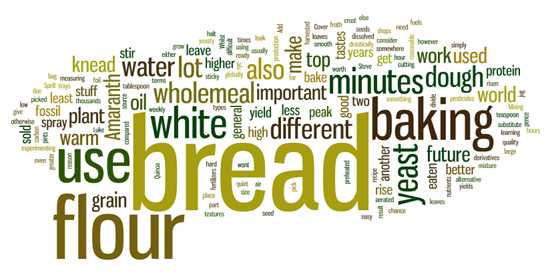A lot of the stuff that is sold as bread in supermarkets really should be called something else, bread the world over is flour, water and yeast, and a world of variations of this based on the bread baked and eaten by different cultures globally. Baking your own proper bread isn’t difficult, and when hard times are with us, it can work out a lot cheaper than buying that ‘other’ stuff that is sold as bread. Apart from it costing a lot less to make, it also tastes a lot better than that aerated rubbish from the shops and you get some satisfaction out of the process of learning how to make good bread.
How do you make bread?
 The recipe that I use for my three weekly bread baking session are 1 kilogram of flour, one tablespoon of fresh yeast that has been activated, and 1.5 pints of cold water. The start your yeast stir a teaspoon of sugar into a measuring jug of Luke warm water, then stir your yeast in until it has dissolved, after about twenty minutes, the yeast will have started to rise and a froth will be developing on top of the liquid, it is now ready to use. Add the yeasty water to the flour and work into dough, then knead it for about 5-8 minutes, add a little flour it is too sticky and continue to knead until it is a solid smooth ball.
The recipe that I use for my three weekly bread baking session are 1 kilogram of flour, one tablespoon of fresh yeast that has been activated, and 1.5 pints of cold water. The start your yeast stir a teaspoon of sugar into a measuring jug of Luke warm water, then stir your yeast in until it has dissolved, after about twenty minutes, the yeast will have started to rise and a froth will be developing on top of the liquid, it is now ready to use. Add the yeasty water to the flour and work into dough, then knead it for about 5-8 minutes, add a little flour it is too sticky and continue to knead until it is a solid smooth ball.
Cover your dough up and leave it somewhere warm to rise for around two hours, once it has risen to twice the size, knead the dough again until you have flattened all of the air out of it, divide the dough up into 4 baking trays and leave for at least another hour in a warm place, then bake in a preheated over at 200 degrees for 35 minutes, if you want a crust top to your bread, get a plant sprayer and lightly spray the top of your loaves when they have been in the oven for 15 minutes, then spray them again at 30 minutes.
Types of flour
 There are lots of different types of flour about that be used for baking bread, I usually use a mixture of wholemeal, spelt, white, and rye. In terms of health and nutrition, wholemeal flour as a general use bread baking flour is better for us than white flour, when I use wholemeal and white together I use at least 65% wholemeal compared to white, similarly, Spelt flour is also high in protein and other nutrients. The reason I have been using white flour in my general bread baking is that I had a source for a few years where I could pick up a 1.5 kilo bag of reasonable quality white flour for 59 pence. Mixing different flours will give you different textures and tastes; it is worth while experimenting once you have picked up the rudiments of baking good bread.
There are lots of different types of flour about that be used for baking bread, I usually use a mixture of wholemeal, spelt, white, and rye. In terms of health and nutrition, wholemeal flour as a general use bread baking flour is better for us than white flour, when I use wholemeal and white together I use at least 65% wholemeal compared to white, similarly, Spelt flour is also high in protein and other nutrients. The reason I have been using white flour in my general bread baking is that I had a source for a few years where I could pick up a 1.5 kilo bag of reasonable quality white flour for 59 pence. Mixing different flours will give you different textures and tastes; it is worth while experimenting once you have picked up the rudiments of baking good bread.
The future of bread baking
 We have eaten bread for thousands of years as an important part of our diet, however, we will have to rethink how we use grain in the due to peak oil and soil depletion as a result of peak oil and the over use of fertilizers and pesticides, which are also derivatives and by products of oil and the fossil duel industries. Whilst there is a chance can some grain for bread making can be freed up as large scale meat production in a post carbon world grinds to halt, we do need to consider either cutting down on eating drastically, or look at alternatives. There is currently a quiet resurgence in growing Amaranth for seed, which can then be used to bake bread; Amaranth has a far higher yield than conventional grain and a higher level of protein and other minerals.
We have eaten bread for thousands of years as an important part of our diet, however, we will have to rethink how we use grain in the due to peak oil and soil depletion as a result of peak oil and the over use of fertilizers and pesticides, which are also derivatives and by products of oil and the fossil duel industries. Whilst there is a chance can some grain for bread making can be freed up as large scale meat production in a post carbon world grinds to halt, we do need to consider either cutting down on eating drastically, or look at alternatives. There is currently a quiet resurgence in growing Amaranth for seed, which can then be used to bake bread; Amaranth has a far higher yield than conventional grain and a higher level of protein and other minerals.
With Amaranth the leaves can also be harvested as a spinach substitute, this gives this plant two yields, which is vitally important in future without fossil fuels. Similarly, Quinoa is a another plant that is quite easy to grow with a high yield of usable seeds that can be used in salads and baking bread. In a low impact future it is important that begin to use these alternative grains that produce a greater yeald for less work, we simply wont have the foil to do otherwise.
Steve

